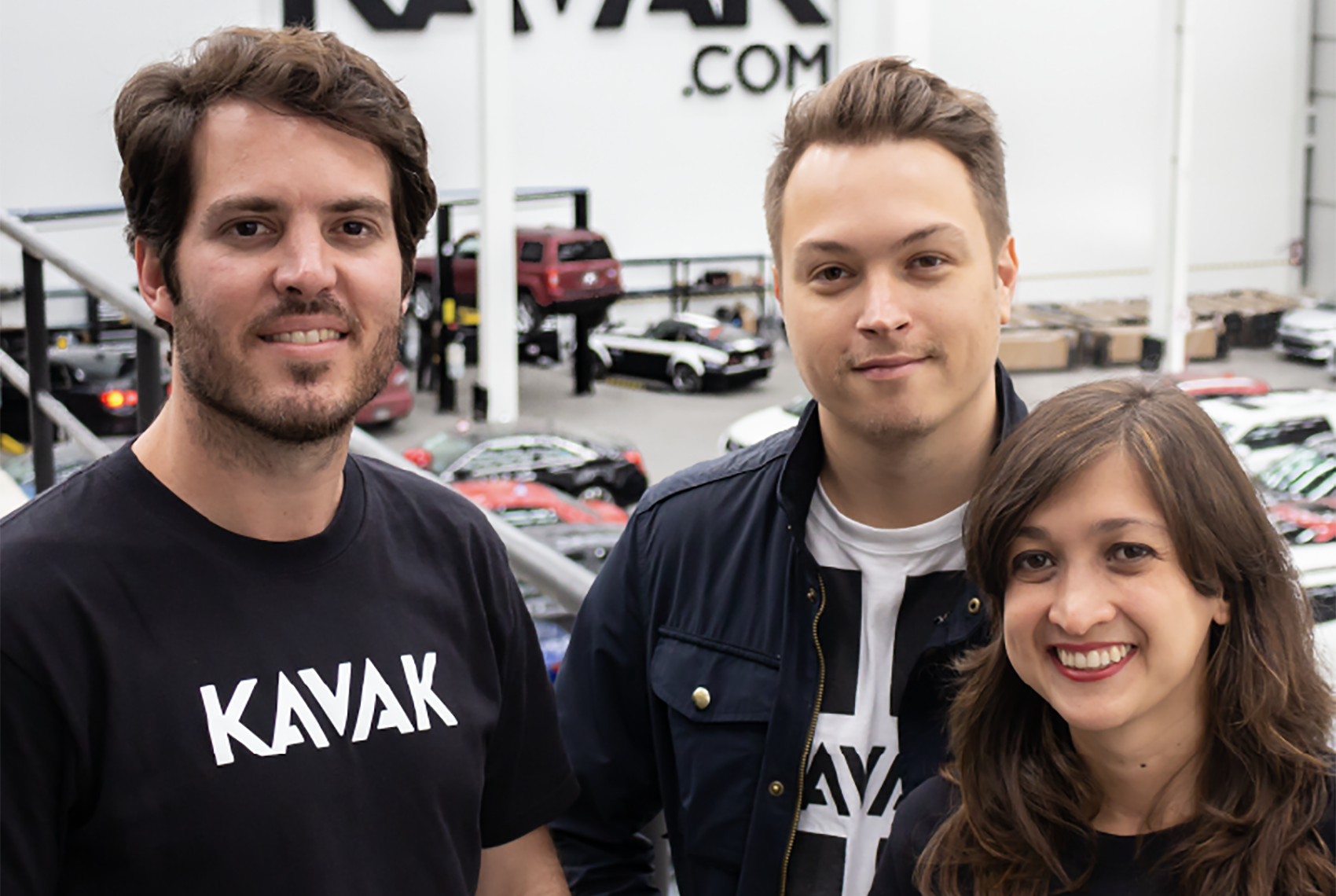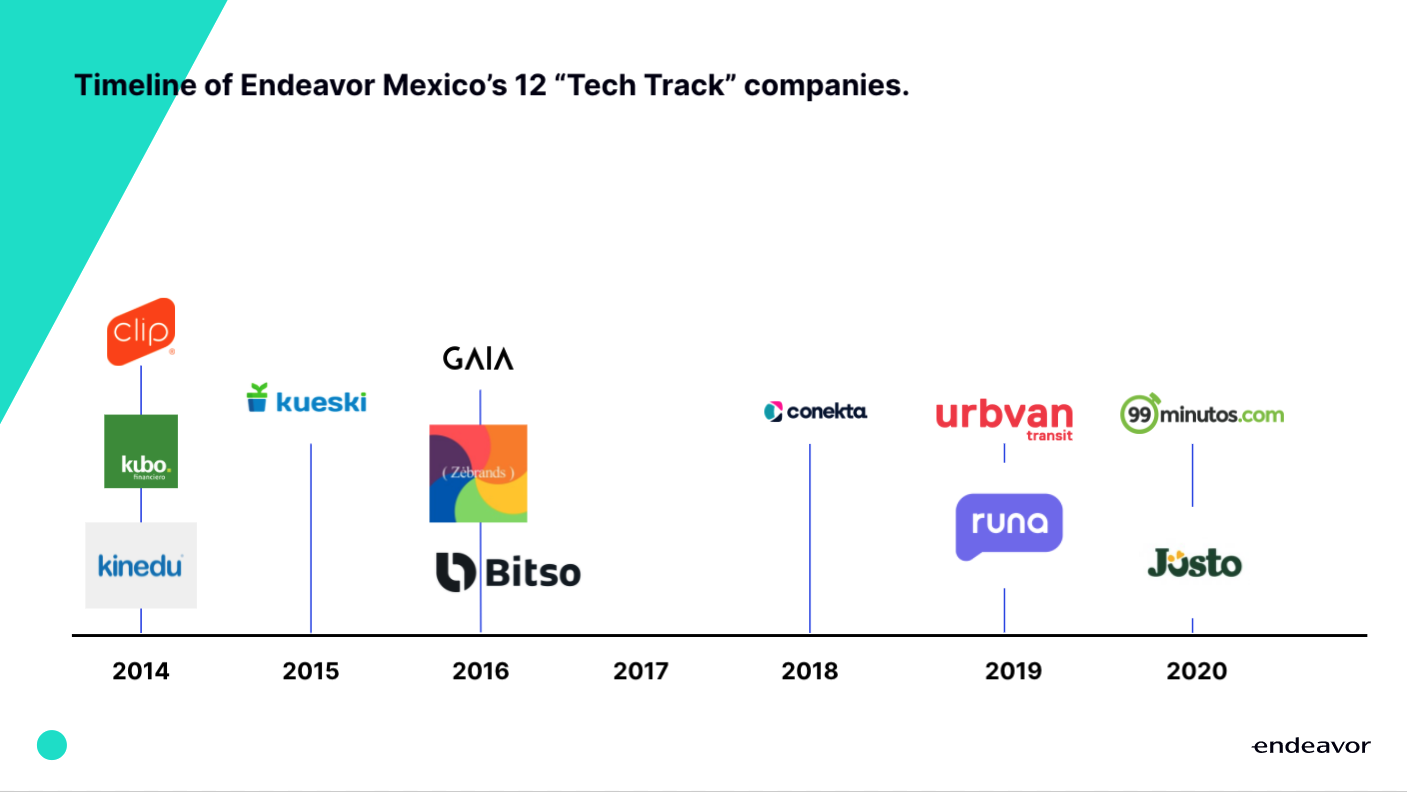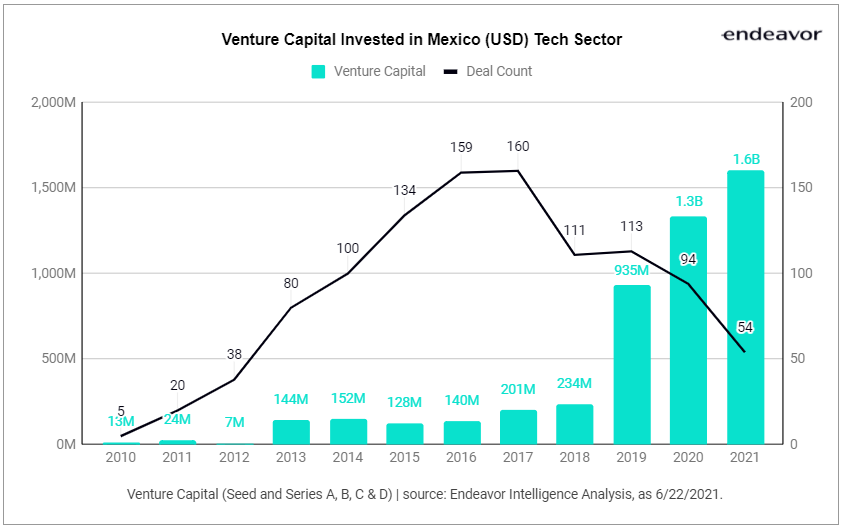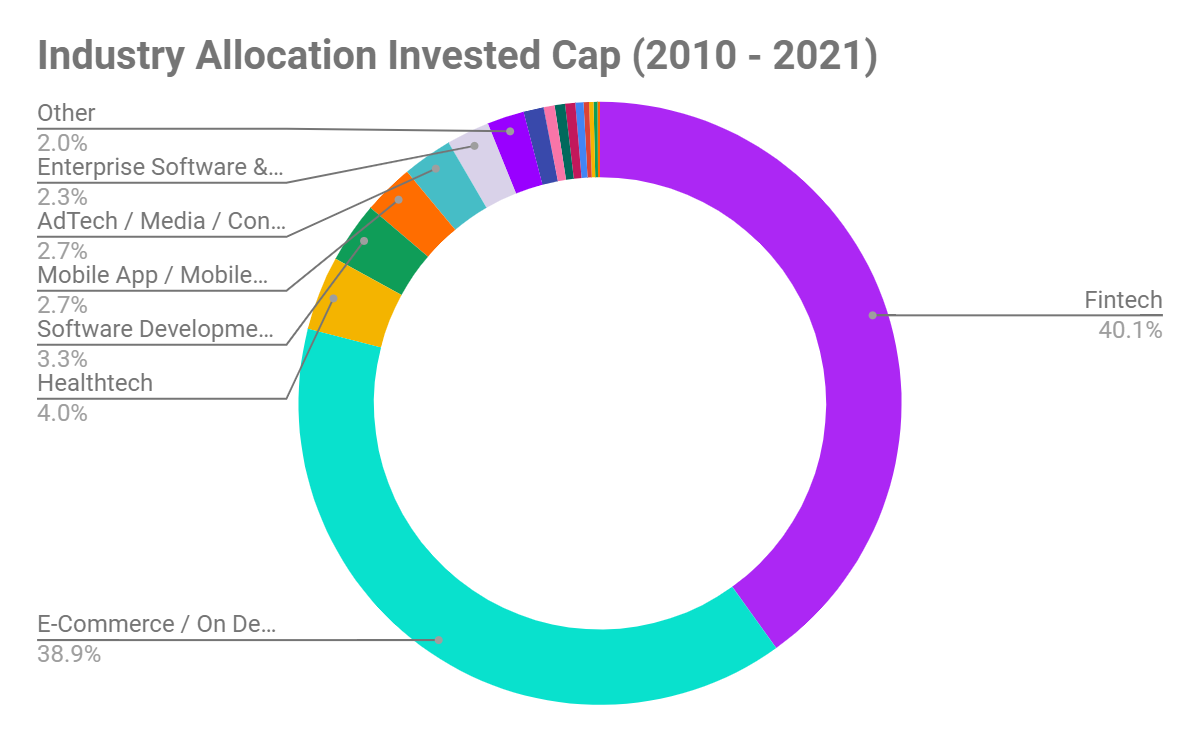On June 10th, Mexico minted its third unicorn: Clip. The Mexican payments fintech targeting small and midsize companies, led by Adolfo Babatz, raised $250 million from SoftBank’s Latin American fund and Viking Global Investors, achieving a $2 billion valuation. The news broke merely five weeks after Mexico ushered in its second unicorn: Bitso. The Latin American cryptocurrency platform raised a $250 million Series C that boosted its valuation to $2.2 billion, five months after it had announced a record-breaking $62 million Series B, the largest in the region for a digital asset firm. Bitso’s news came just seven months after Mexico’s used car marketplace, Kavak, became the country’s first startup unicorn… ever!
Why do we celebrate the existence of these Mexican unicorns? As Vincent Speranza, Managing Director of Endeavor Mexico, recently shared: “We are not only happy about what it means for our Endeavor Entrepreneurs Carlos Garcia, Loreanne Garcia, and Roger Laughlin (Kavak), Pablo González, Ben Peters, and Daniel Vogel (Bitso), and Adolfo Babatz (Clip), but also for the great impact that their organizations will have on the country and on the ecosystem.” A unicorn company not only drives meaningful economic growth and creates high-quality jobs, but it also becomes a source of inspiration for entrepreneurs, investors, and employees looking to start or seed ventures of their own.
The private market momentum in Mexico is undeniable, but is it due to magic, happenstance, luck? We argue that it’s none of these things, in fact, it is the culmination of two decades of ecosystem building that has prepared Mexico and its entrepreneurs for this moment…or shall we say, movement.
Productivity woes
Despite being the most populous Spanish-speaking country in the world and second largest economy in Latin America — behind Brazil — Mexico’s tech sector long disappointed. The country has always held great promise with its unique geographic advantages: bustling ports on two oceans, abundant natural resources, an established industrial sector, close business ties and proximity to the US, and a young population. But, Mexico has faltered. Despite reasonable monetary and fiscal policy and open trade, productivity has stagnated largely due to misaligned government incentives, a lack of investment in education, and the country’s historic oligopolistic nature.
Of the 4.8 million small and medium-sized enterprises (SMEs) in Mexico, the vast majority are micro-enterprises (95%) — defined as having at most ten workers — and employ 37% of the country’s workforce. Of these workers, about 88% are “informal” versus “salaried”. These informal workers tend to be less productive than salaried workers, resulting in gross output that represents a mere ~11% of Mexico’s GDP.
Informal workers are defined by being either self-employed or paid piece-rates or profit-shares, and firms are only required to pay annual corporate tax on these employees. Conversely, firms with salaried employees must also pay social insurance, deduct income tax, and deal with employment law, which prohibits terminating employees without cause. All the while, it has been shown that salaried workers are much more productive than informal workers.
In fact, the country has secured its position as having the widest labor productivity gap between SMEs and large firms across OECD countries, with the productivity gap between small enterprises of up to 50 employees and large firms being particularly wide. All of these factors have contributed to Mexico having the lowest GDP per capita and the highest poverty levels in the OECD.
But the narrative is changing, thanks in large part to entrepreneurship and significant investments in the ecosystem.
In his piece, “Mexico’s Growth Will Come From Entrepreneurship and Small and Medium-Sized Enterprises” published in 2012, Álvaro Rodríguez Arregui, Co-Founder and Managing Partner of IGNIA shares that large companies in Mexico have shown impressive growth, but it has not translated into a higher GDP because these companies have not increased the size of the pie; they have captured a greater piece of the existing pie.
Alvaro argues that Mexico is left with two options to positively impact GDP: to create more micro-enterprises or to increase the growth of its Small and Medium-Sized Enterprises (SMEs). To increase GDP by one percentage point, the country would need to add 273,000 microenterprises; conversely, 105 mid-sized companies would need to grow from medium to large to achieve the same result, a more efficient proposition.
The first decade
By 2001, Endeavor was a well-known organization across Latin America. Launched in 1997, Endeavor had since established a presence in Brazil, Chile, and Argentina and was closely tied to up-and-coming entrepreneurs like Marcos Galperin and Hernan Kazah at MercadoLibre and Wences Casares at Patagon. Endeavor’s focus on identifying the highest potential companies and helping them scale seemed to align perfectly with Mexico’s shortcomings. With local support, Endeavor Mexico officially launched in 2002.
With boots on the ground, the Endeavor Mexico team went to work. They identified the highest-potential entrepreneurs leading the fastest-growing companies in the country, and offered mentorship and other demand-driven services to help them scale. The companies were largely in traditional sectors like retail and food & beverage, with traditional business models including Cafe Punta del Cielo, a producer and distributor of gourmet coffee, and Chilim Balam, a confectionery of Mexican treats.
And while not core to the model at the time, some early technology companies were selected into the Endeavor network. Unfortunately in this case, they were way ahead of their time; ahead of venture capital, tech talent, tech adoption, cloud computing, data analytics, and internet and mobile phone penetration in the country. These companies included Bebemundo.com, Adam Technologies, Venta Kit, Metros Cubicos, Quarksoft, CitiVox — all disrupting their respective industries in ecommerce, HR, payments, real estate, marketing, and media, but without the necessary technological infrastructure or capital to scale. These companies — in many ways entrepreneurial martyrs — proved that the Mexican tech ecosystem had a long way to go until it would become a hotbed of innovation.
Sowing seeds
In 2012, ecommerce site Linio launched in the country. Ecommerce was essentially non-existent in Mexico at the time; MercadoLibre was not yet relevant in the country and Amazon had not yet entered the market. As with many early innovations in emerging markets, Linio had to effectively vertically integrate in order to succeed. The team was tasked with building out not only their core business and driving adoption, but also building all of the supporting functions in order to operate: payments, logistics, security, talent, and more.
Through their significant efforts, Linio sowed the seeds for a thriving entrepreneurial ecosystem and spurred a multiplier effect in the ecommerce industry in the country. Founders and former employees of Linio went on to start at least 66 companies, including some of the most important ecommerce companies in Mexico today, including Kavak, Luuna (now ZeBrands), and Urbvan. These founders learned valuable lessons from their time at Linio and benefited tremendously from the inflow of talent and creation of critical infrastructure. Read more about the history of Linio here.
More risk, more reward
That same year — 2012 — Vincent Speranza, Director of Operations of Endeavor Mexico at the time, flew to New York City to attend a meeting with the leaders of Endeavor’s local offices worldwide, hosted by the organization’s Founder and CEO, Linda Rottenberg. One by one the representatives from each office gave status updates, and Vincent proudly reported that 94% of companies selected by Endeavor Mexico were alive post-selection into the Endeavor network.
He remembers Linda’s signature smile fading as he spoke, and she interjected, “This is why Mexico is the way it is. You aren’t taking any risk.” She continued emphatically, “Endeavor is not about average companies — Endeavor is about outliers, and outliers are about technology.”
It was not the reaction Vincent had anticipated; a bit stunned, he took the feedback to heart. A few months later, Vincent launched Endeavor Mexico’s “Tech Track”, which began as a side program to the broader selection process, and aimed to attract the country’s budding technology companies. Vincent and team went back to the drawing board — reimagining everything from the mentors in their network to their programming — to cater to this new audience.
An outlier
In 2014, Endeavor Mexico selected its first official tech entrepreneur and company: Adolfo Babatz, Founder and CEO of Clip.
Adolfo was born and raised in Mexico. He graduated from Mexico City’s ITAM in 2001 and after working in both banking and consulting, he pursued his MBA at MIT’s Sloan School of Management. Between his first and second years at MIT he interned on PayPal’s Latin America team, which he ultimately joined full time in 2008 upon graduating. As PayPal’s third employee for LatAm, Adolfo worked on multiple projects including establishing the company’s presence in both Mexico and Brazil.
After working in Mexico for several months, Adolfo realized there was a critical need for a product that would allow SMEs to accept credit card and debit card payments. The team at PayPayl didn’t seem to agree. Convinced that this was the way forward, Adolfo left PayPal to attempt solving this massive problem, and Clip was born. Adolfo was the first Mexican entrepreneur with a true Silicon Valley mindset — and he had his eyes set on something big.
A bet on tech
While Clip was the first official tech company to join Endeavor Mexico’s ranks — it certainly wasn’t the only. Endeavor’s “Tech Track” gained traction, and selected a number of innovative and disruptive companies. Endeavor played a crucial role in helping these companies scale by providing mentorship, an unrivaled peer-to-peer network, access to new markets and talent, and above all, being an ally through the ups and downs of entrepreneurship.
“I am a completely changed person for the better,” Adolfo has said. “Especially those early years — 2014 and 2015 — were instrumental in what I eventually became, and Endeavor was very important in that process. I am different because of what I had to go through in the early years; it was rough — I made so many mistakes,” Adolfo recalls, “and Endeavor was my safe place.”
As the cohort of technology entrepreneurs grew, an additional service Endeavor needed to offer was “Access to Capital”. At the time, venture capital was in its infancy, and most companies were backed by family and friends, which was not a recipe for scaling. The Endeavor team set out to establish relationships with local, regional, and global funds with an interest in Mexico.
Hector Sepulveda, Founder of Litebuilt, who went on to start local venture capital firm Mountain Nazca, expressed: “My first true surprise as a founder was being invited, accepted and supported by Endeavor. It showed me the value of meritocracy in a region where access to resources had been extremely privileged. Ultimately, the learnings enabled by Endeavor motivated me to build a firm that provides revolutionary empowerment to leaders based on merit.”
Like any good tech company, Endeavor Mexico had succeeded in pivoting; it became abundantly clear that technology was the way of the future and perhaps the only way that Mexico would advance as both a workforce and an economy.
A nascent venture capital industry
According to today’s headlines, venture capital is booming in Mexico, but this hasn’t always been the case. In fact, the venture capital industry in Mexico is still quite young. According to data gathered by the Mexican Private Capital Association (AMEXCAP), there was no venture capital activity in Mexico in 2007.
Things started to change in 2008 with registered venture capital totaling USD $102 million, and growing 25% to USD $128 million in 2009, before decreasing due to the global economic crisis. Venture capital in Mexico peaked in 2014, which can be attributed to a program created by the National Entrepreneurship Institute (INADEM) that launched 26 venture capital funds in 2013 and 2014. An additional 14 funds were launched over the next two years.
“When we raised our first round in early 2013 — we raised $1.5 million and it was a scandal,” Adolfo recalls. At the time, people didn’t quite understand what that company did, who was behind it, or why anyone would give the company a million dollars. In short, it was crazy. Clip went on to raise an $8 million Series B in 2015 and “it was still crazy,” says Adolfo. In 2016, Clip raised $30 million from General Atlantic. Each round the company raised was the highest round ever for a tech startup in the country. “Money is now a commodity,” Adolfo states, “back then it was not.”
Venture capital in Mexico continued to grow steadily in the second half of the 2010s. According to AMEXCAP, investments in Mexican start-ups grew at a 69% compounded annual growth rate during the five-year period from 2014 to 2019. Following strong performance in 2019, activity boomed in 2020 amidst the global pandemic, which gave rise to significant digital innovation and adoption in the country — particularly in fintech and ecommerce. In 2021 to date, venture capital has already surpassed its 2020 levels, though more capital is going to fewer deals.
Foreign investors have taken notice of the market opportunities, and are fundamentally changing the landscape by injecting not only capital, but also further credibility into the ecosystem. This really started in 2014–2015 with AMEX Ventures and Sierra Ventures investing in Clip, but accelerated in 2017 with investors like General Atlantic, Accel, a16z, Sequoia, Goldman Sachs, and more recently Softbank and Greenoaks, growing increasingly active, and even leading mega-rounds in the country. A few weeks ago, Konfio announced its $125 million round led by Softbank and London-based Lightrock.
These investors are following the lead of local venture capital firms like Dalus, Mountain Nazca, Jaguar, Angel Ventures, ALLVP, Cometa, IGNIA, and others that have funded the ecosystem for years. Local investors are typically investing in seed and early stage rounds, playing a critical role in getting companies off the ground and preparing them to receive both global capital and attention.
Despite significant progress, the Mexican venture capital industry is still very much in its infancy. However, with an average 10 year fund life and 6–8 year holding period, many local funds established in the 2000s are now beginning to achieve demonstrable results.
Just last month, Uber announced it would acquire the remaining shares of Cornershop, valuing the company at $3 billion and marking the first significant exit for the entrepreneurial tech ecosystem. Cornershop, a leading on-demand grocery delivery company in Latin America, was founded simultaneously in Santiago, Chile and Mexico City in 2015. Early investors in the company include ALLVP, who seeded the company and participated in all future funding rounds. All’s well that ends well, but the exit was not without drama. In 2018, Walmart announced it would acquire Cornershop for $225 million, but the deal was ultimately blocked by Mexican antitrust authorities in June 2019. Just a few months later, Uber announced it would purchase a majority stake in the company for $450 million. The initial transaction was finalized in early 2021, and the full acquisition is set to close in July. With this exit, ALLVP successfully completed a full venture capital cycle. From fundraising, to investing, to returning capital to the family offices, pension funds, development banks, and entrepreneurs who backed them.
A place in the sun
While still small, Mexico’s unicorn club (and startup landscape more broadly) is growing at a record pace, with “soonicorns” like Justo waiting to be admitted. And while from the outside looking in it may seem like the work of magic, Mexico’s success is due to two decades of ecosystem building, and the commitment of both time and capital of the many stakeholders who have believed in the country’s promise. As Carlos Garcia, ex-Linio executive who went on to found Kavak has said, “I want to be inside the entrepreneurial ecosystem and be a part of the change.”
To see Mexico take its place in the sun is a source of great pride for many, and likely the way forward for the economy at large. The journey, as most entrepreneurs can attest, has not been easy. And the recent attention from both investors and media outlets is not an outcome per se; similar to achieving unicorn status, it is just a mile marker along the way. Many of these eye-popping gains are still unrealized and the ecosystem is only on its first venture capital cycle. Will the capital markets hold? Will Mexico continue to rise to the occasion, investing further in education and technological infrastructure to support this innovation? Will these successful companies spawn and inspire other entrepreneurs and will these entrepreneurs choose to stay local? Will the entrepreneurs who have “made it” pay their success forward by mentoring and investing in the next generation? Will the ability to create significant value be further democratized — allowing citizens from Tijuana to Cancun to pursue entrepreneurial ambitions no matter their gender, socio-economic status, or education? These are the hallmarks of successful and enduring entrepreneurial ecosystems. We are certainly optimistic; it is imperative that the country’s success to date continues to breed hard work and not complacency.
Further, it is important to acknowledge the role that macroeconomic trends and tailwinds have played. Significant monetary and fiscal support as a result of the global pandemic, has increased risk appetite for all asset classes — leading to record amounts of capital being poured into the venture capital asset class and managers increasingly looking to markets outside of the US and China to deploy. And investors’ increased comfort making investments via Zoom has made physical geography less of a factor. Will this continue? We shall see, but we have reason to believe that it will.
In NPRs popular podcast “How I Built This”, host Guy Raz asks his guests “How much of your success do you attribute to luck, or just hard work?” Nearly every guest concedes that it’s a fair amount of both; after all, luck is what happens when preparation meets opportunity. In the case of Mexico, it has been the hard work and preparation of so many that has prepared the country to seize the opportunity of today, and propelled Mexico onto the global entrepreneurial stage. Now, the country must perform.
Heading into 2021, we at Endeavor predicted that Mexico would have its moment (see prediction #7 on this list here). Just halfway through the year, and this has undoubtedly come true. But something even bigger is now underway; for Mexico’s entrepreneurial tech ecosystem — two decades in the making — we believe this is more than a moment, it’s a movement!
Jackie Carmel is Managing Director at Endeavor Catalyst — you can reach her on LinkedIn here.
Special thanks to the Endeavor Mexico Team, particularly Vincent Speranza, Enrico Robles, Javier Valdez, and Patricia Gameros for their contributions to this piece.
Featured Stories
Reid Hoffman (and his AI twin) on the cognitive industrial revolution

Behind Endeavor’s Expansion: How We Grew to 45 Countries

Behind The Curtain: Why We Selected Polish AI Audio Startup ElevenLabs

Riding the Black Swan: Why Entrepreneurship Is Even More Important in Crisis-prone Regions

Related Articles

Reid Hoffman (and his AI twin) on the cognitive industrial revolution

Behind Endeavor’s Expansion: How We Grew to 45 Countries






